Analysis of McDonald's and Hungry Jack's Business Strategies - ECO600
VerifiedAdded on 2023/03/23
|10
|3434
|28
Report
AI Summary
This report provides a comprehensive analysis of McDonald's and Hungry Jack's operations within the Australian fast-food market. It examines the market structure, identifying it as oligopolistic, and explores the pricing and non-pricing strategies employed by both companies, including bundling, psychological pricing, and promotional activities. The report highlights McDonald's market dominance and the importance of differentiation, while also suggesting opportunities for Hungry Jack's to compete more effectively, particularly by addressing health-conscious consumer preferences. Furthermore, the analysis delves into competitive strategies, market share, and recommendations for business improvements, offering insights into value pricing, penetration pricing, and the need for Hungry Jack's to adapt to evolving consumer demands. The report concludes by synthesizing the key findings and providing strategic advice for both companies to enhance their market positions.
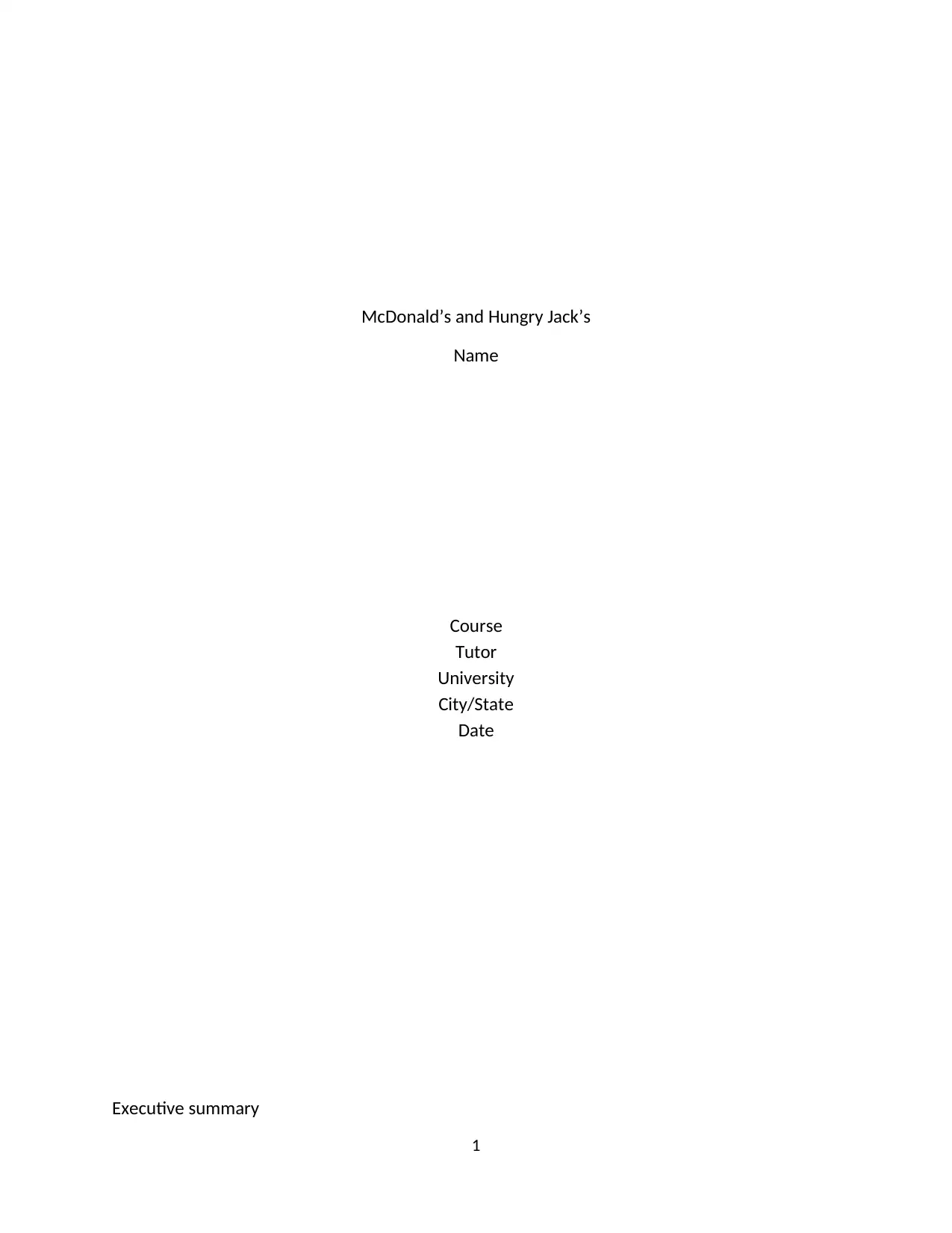
McDonald’s and Hungry Jack’s
Name
Course
Tutor
University
City/State
Date
Executive summary
1
Name
Course
Tutor
University
City/State
Date
Executive summary
1
Paraphrase This Document
Need a fresh take? Get an instant paraphrase of this document with our AI Paraphraser
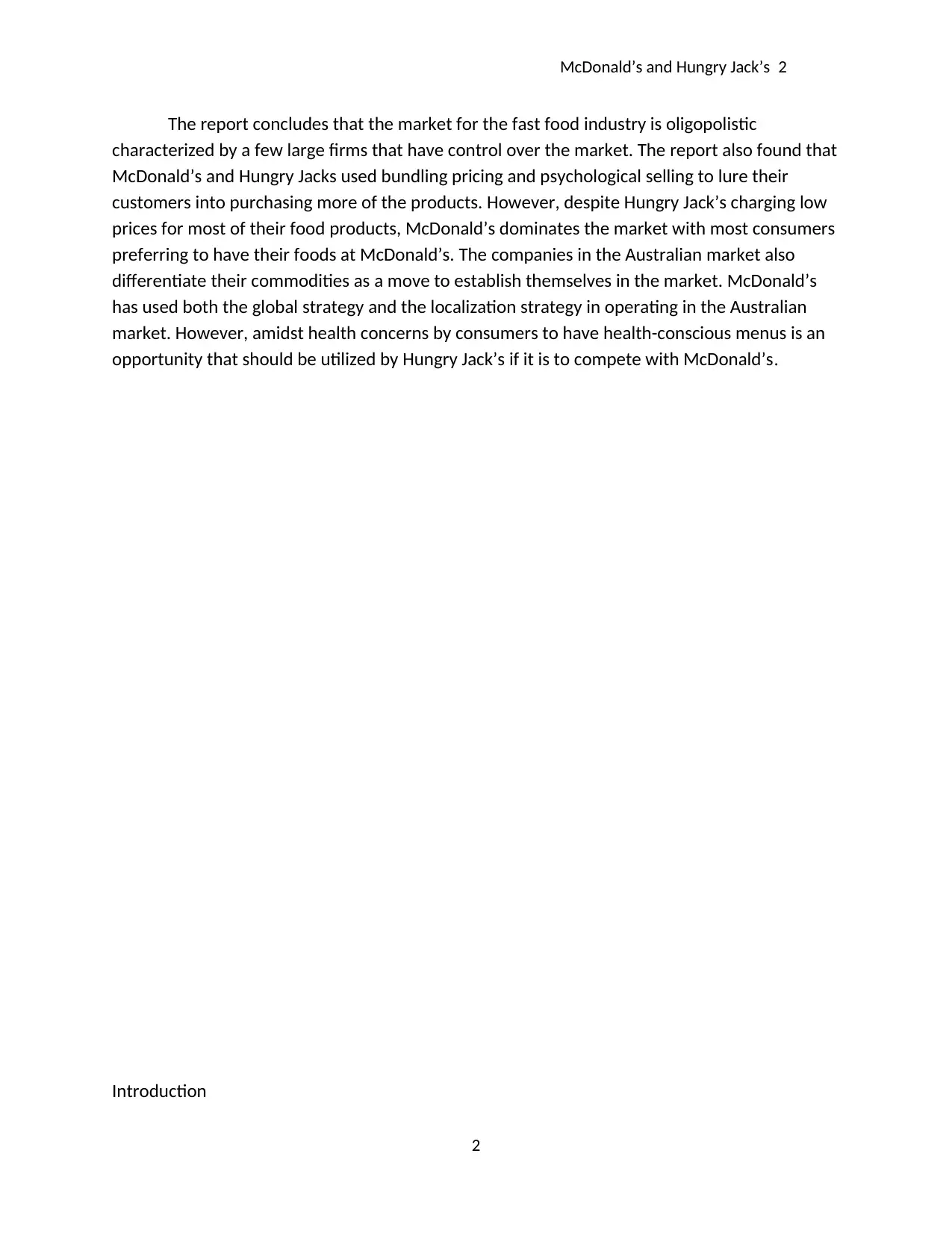
McDonald’s and Hungry Jack’s 2
The report concludes that the market for the fast food industry is oligopolistic
characterized by a few large firms that have control over the market. The report also found that
McDonald’s and Hungry Jacks used bundling pricing and psychological selling to lure their
customers into purchasing more of the products. However, despite Hungry Jack’s charging low
prices for most of their food products, McDonald’s dominates the market with most consumers
preferring to have their foods at McDonald’s. The companies in the Australian market also
differentiate their commodities as a move to establish themselves in the market. McDonald’s
has used both the global strategy and the localization strategy in operating in the Australian
market. However, amidst health concerns by consumers to have health-conscious menus is an
opportunity that should be utilized by Hungry Jack’s if it is to compete with McDonald’s.
Introduction
2
The report concludes that the market for the fast food industry is oligopolistic
characterized by a few large firms that have control over the market. The report also found that
McDonald’s and Hungry Jacks used bundling pricing and psychological selling to lure their
customers into purchasing more of the products. However, despite Hungry Jack’s charging low
prices for most of their food products, McDonald’s dominates the market with most consumers
preferring to have their foods at McDonald’s. The companies in the Australian market also
differentiate their commodities as a move to establish themselves in the market. McDonald’s
has used both the global strategy and the localization strategy in operating in the Australian
market. However, amidst health concerns by consumers to have health-conscious menus is an
opportunity that should be utilized by Hungry Jack’s if it is to compete with McDonald’s.
Introduction
2
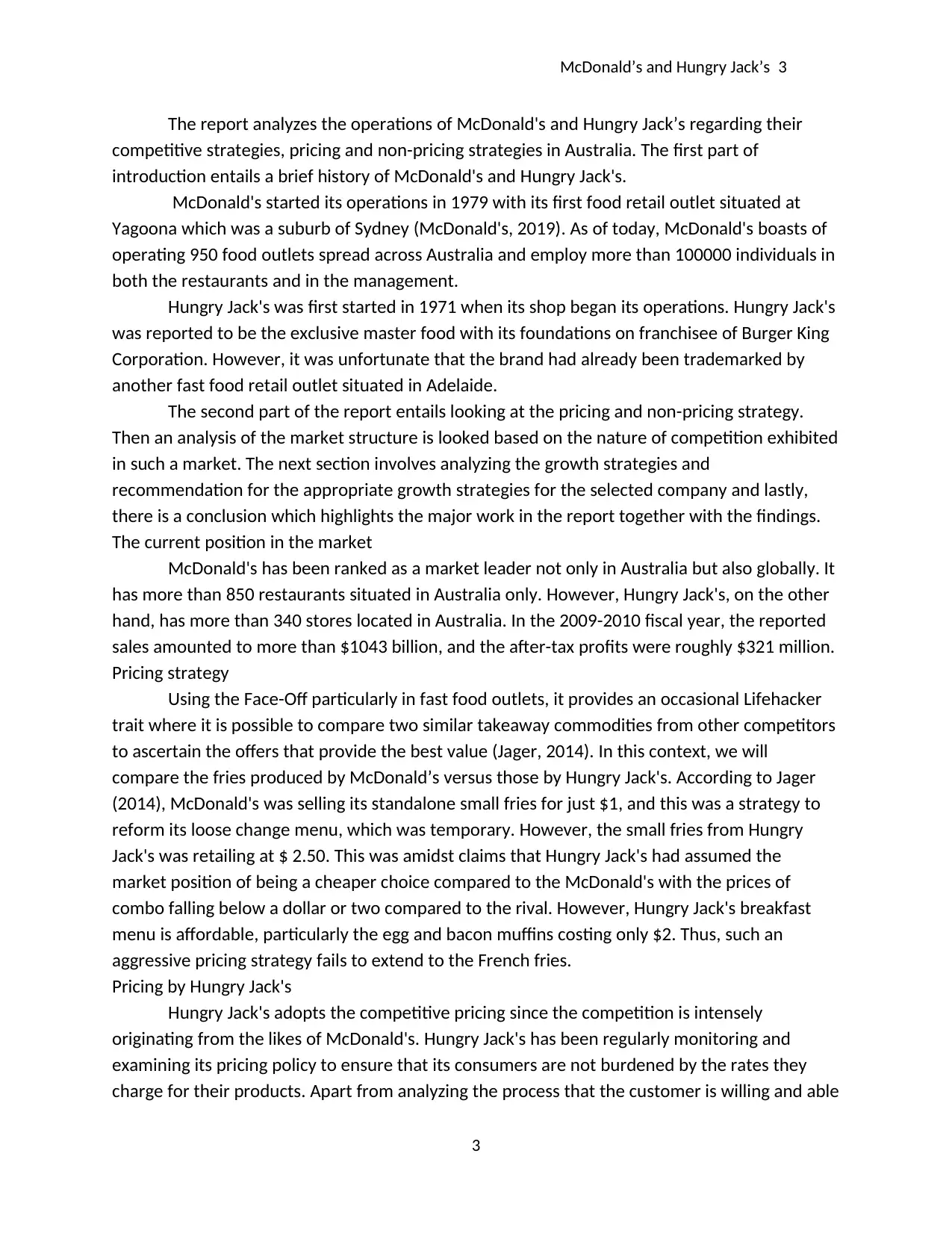
McDonald’s and Hungry Jack’s 3
The report analyzes the operations of McDonald's and Hungry Jack’s regarding their
competitive strategies, pricing and non-pricing strategies in Australia. The first part of
introduction entails a brief history of McDonald's and Hungry Jack's.
McDonald's started its operations in 1979 with its first food retail outlet situated at
Yagoona which was a suburb of Sydney (McDonald's, 2019). As of today, McDonald's boasts of
operating 950 food outlets spread across Australia and employ more than 100000 individuals in
both the restaurants and in the management.
Hungry Jack's was first started in 1971 when its shop began its operations. Hungry Jack's
was reported to be the exclusive master food with its foundations on franchisee of Burger King
Corporation. However, it was unfortunate that the brand had already been trademarked by
another fast food retail outlet situated in Adelaide.
The second part of the report entails looking at the pricing and non-pricing strategy.
Then an analysis of the market structure is looked based on the nature of competition exhibited
in such a market. The next section involves analyzing the growth strategies and
recommendation for the appropriate growth strategies for the selected company and lastly,
there is a conclusion which highlights the major work in the report together with the findings.
The current position in the market
McDonald's has been ranked as a market leader not only in Australia but also globally. It
has more than 850 restaurants situated in Australia only. However, Hungry Jack's, on the other
hand, has more than 340 stores located in Australia. In the 2009-2010 fiscal year, the reported
sales amounted to more than $1043 billion, and the after-tax profits were roughly $321 million.
Pricing strategy
Using the Face-Off particularly in fast food outlets, it provides an occasional Lifehacker
trait where it is possible to compare two similar takeaway commodities from other competitors
to ascertain the offers that provide the best value (Jager, 2014). In this context, we will
compare the fries produced by McDonald’s versus those by Hungry Jack's. According to Jager
(2014), McDonald's was selling its standalone small fries for just $1, and this was a strategy to
reform its loose change menu, which was temporary. However, the small fries from Hungry
Jack's was retailing at $ 2.50. This was amidst claims that Hungry Jack's had assumed the
market position of being a cheaper choice compared to the McDonald's with the prices of
combo falling below a dollar or two compared to the rival. However, Hungry Jack's breakfast
menu is affordable, particularly the egg and bacon muffins costing only $2. Thus, such an
aggressive pricing strategy fails to extend to the French fries.
Pricing by Hungry Jack's
Hungry Jack's adopts the competitive pricing since the competition is intensely
originating from the likes of McDonald's. Hungry Jack's has been regularly monitoring and
examining its pricing policy to ensure that its consumers are not burdened by the rates they
charge for their products. Apart from analyzing the process that the customer is willing and able
3
The report analyzes the operations of McDonald's and Hungry Jack’s regarding their
competitive strategies, pricing and non-pricing strategies in Australia. The first part of
introduction entails a brief history of McDonald's and Hungry Jack's.
McDonald's started its operations in 1979 with its first food retail outlet situated at
Yagoona which was a suburb of Sydney (McDonald's, 2019). As of today, McDonald's boasts of
operating 950 food outlets spread across Australia and employ more than 100000 individuals in
both the restaurants and in the management.
Hungry Jack's was first started in 1971 when its shop began its operations. Hungry Jack's
was reported to be the exclusive master food with its foundations on franchisee of Burger King
Corporation. However, it was unfortunate that the brand had already been trademarked by
another fast food retail outlet situated in Adelaide.
The second part of the report entails looking at the pricing and non-pricing strategy.
Then an analysis of the market structure is looked based on the nature of competition exhibited
in such a market. The next section involves analyzing the growth strategies and
recommendation for the appropriate growth strategies for the selected company and lastly,
there is a conclusion which highlights the major work in the report together with the findings.
The current position in the market
McDonald's has been ranked as a market leader not only in Australia but also globally. It
has more than 850 restaurants situated in Australia only. However, Hungry Jack's, on the other
hand, has more than 340 stores located in Australia. In the 2009-2010 fiscal year, the reported
sales amounted to more than $1043 billion, and the after-tax profits were roughly $321 million.
Pricing strategy
Using the Face-Off particularly in fast food outlets, it provides an occasional Lifehacker
trait where it is possible to compare two similar takeaway commodities from other competitors
to ascertain the offers that provide the best value (Jager, 2014). In this context, we will
compare the fries produced by McDonald’s versus those by Hungry Jack's. According to Jager
(2014), McDonald's was selling its standalone small fries for just $1, and this was a strategy to
reform its loose change menu, which was temporary. However, the small fries from Hungry
Jack's was retailing at $ 2.50. This was amidst claims that Hungry Jack's had assumed the
market position of being a cheaper choice compared to the McDonald's with the prices of
combo falling below a dollar or two compared to the rival. However, Hungry Jack's breakfast
menu is affordable, particularly the egg and bacon muffins costing only $2. Thus, such an
aggressive pricing strategy fails to extend to the French fries.
Pricing by Hungry Jack's
Hungry Jack's adopts the competitive pricing since the competition is intensely
originating from the likes of McDonald's. Hungry Jack's has been regularly monitoring and
examining its pricing policy to ensure that its consumers are not burdened by the rates they
charge for their products. Apart from analyzing the process that the customer is willing and able
3
⊘ This is a preview!⊘
Do you want full access?
Subscribe today to unlock all pages.

Trusted by 1+ million students worldwide
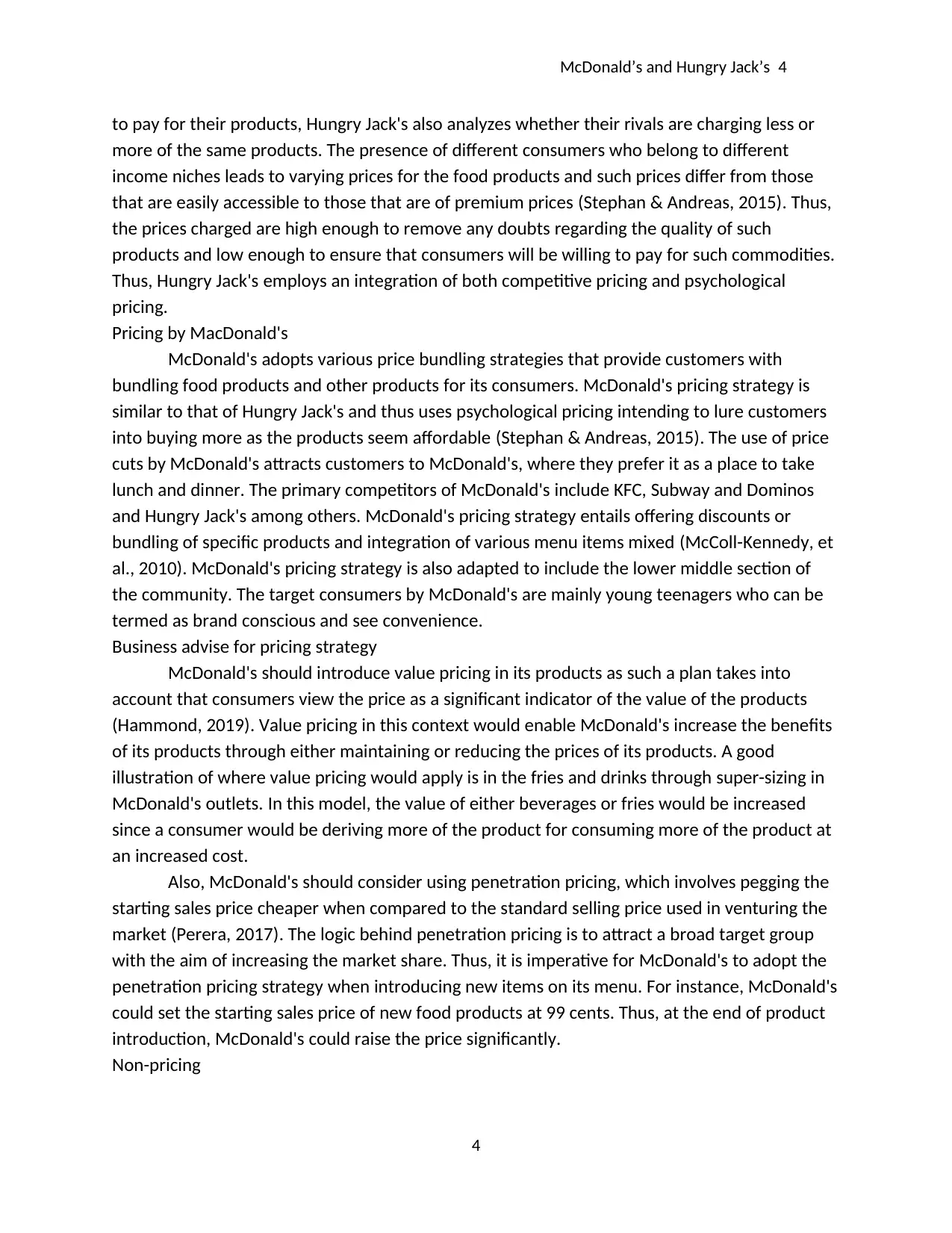
McDonald’s and Hungry Jack’s 4
to pay for their products, Hungry Jack's also analyzes whether their rivals are charging less or
more of the same products. The presence of different consumers who belong to different
income niches leads to varying prices for the food products and such prices differ from those
that are easily accessible to those that are of premium prices (Stephan & Andreas, 2015). Thus,
the prices charged are high enough to remove any doubts regarding the quality of such
products and low enough to ensure that consumers will be willing to pay for such commodities.
Thus, Hungry Jack's employs an integration of both competitive pricing and psychological
pricing.
Pricing by MacDonald's
McDonald's adopts various price bundling strategies that provide customers with
bundling food products and other products for its consumers. McDonald's pricing strategy is
similar to that of Hungry Jack's and thus uses psychological pricing intending to lure customers
into buying more as the products seem affordable (Stephan & Andreas, 2015). The use of price
cuts by McDonald's attracts customers to McDonald's, where they prefer it as a place to take
lunch and dinner. The primary competitors of McDonald's include KFC, Subway and Dominos
and Hungry Jack's among others. McDonald's pricing strategy entails offering discounts or
bundling of specific products and integration of various menu items mixed (McColl-Kennedy, et
al., 2010). McDonald's pricing strategy is also adapted to include the lower middle section of
the community. The target consumers by McDonald's are mainly young teenagers who can be
termed as brand conscious and see convenience.
Business advise for pricing strategy
McDonald's should introduce value pricing in its products as such a plan takes into
account that consumers view the price as a significant indicator of the value of the products
(Hammond, 2019). Value pricing in this context would enable McDonald's increase the benefits
of its products through either maintaining or reducing the prices of its products. A good
illustration of where value pricing would apply is in the fries and drinks through super-sizing in
McDonald's outlets. In this model, the value of either beverages or fries would be increased
since a consumer would be deriving more of the product for consuming more of the product at
an increased cost.
Also, McDonald's should consider using penetration pricing, which involves pegging the
starting sales price cheaper when compared to the standard selling price used in venturing the
market (Perera, 2017). The logic behind penetration pricing is to attract a broad target group
with the aim of increasing the market share. Thus, it is imperative for McDonald's to adopt the
penetration pricing strategy when introducing new items on its menu. For instance, McDonald's
could set the starting sales price of new food products at 99 cents. Thus, at the end of product
introduction, McDonald's could raise the price significantly.
Non-pricing
4
to pay for their products, Hungry Jack's also analyzes whether their rivals are charging less or
more of the same products. The presence of different consumers who belong to different
income niches leads to varying prices for the food products and such prices differ from those
that are easily accessible to those that are of premium prices (Stephan & Andreas, 2015). Thus,
the prices charged are high enough to remove any doubts regarding the quality of such
products and low enough to ensure that consumers will be willing to pay for such commodities.
Thus, Hungry Jack's employs an integration of both competitive pricing and psychological
pricing.
Pricing by MacDonald's
McDonald's adopts various price bundling strategies that provide customers with
bundling food products and other products for its consumers. McDonald's pricing strategy is
similar to that of Hungry Jack's and thus uses psychological pricing intending to lure customers
into buying more as the products seem affordable (Stephan & Andreas, 2015). The use of price
cuts by McDonald's attracts customers to McDonald's, where they prefer it as a place to take
lunch and dinner. The primary competitors of McDonald's include KFC, Subway and Dominos
and Hungry Jack's among others. McDonald's pricing strategy entails offering discounts or
bundling of specific products and integration of various menu items mixed (McColl-Kennedy, et
al., 2010). McDonald's pricing strategy is also adapted to include the lower middle section of
the community. The target consumers by McDonald's are mainly young teenagers who can be
termed as brand conscious and see convenience.
Business advise for pricing strategy
McDonald's should introduce value pricing in its products as such a plan takes into
account that consumers view the price as a significant indicator of the value of the products
(Hammond, 2019). Value pricing in this context would enable McDonald's increase the benefits
of its products through either maintaining or reducing the prices of its products. A good
illustration of where value pricing would apply is in the fries and drinks through super-sizing in
McDonald's outlets. In this model, the value of either beverages or fries would be increased
since a consumer would be deriving more of the product for consuming more of the product at
an increased cost.
Also, McDonald's should consider using penetration pricing, which involves pegging the
starting sales price cheaper when compared to the standard selling price used in venturing the
market (Perera, 2017). The logic behind penetration pricing is to attract a broad target group
with the aim of increasing the market share. Thus, it is imperative for McDonald's to adopt the
penetration pricing strategy when introducing new items on its menu. For instance, McDonald's
could set the starting sales price of new food products at 99 cents. Thus, at the end of product
introduction, McDonald's could raise the price significantly.
Non-pricing
4
Paraphrase This Document
Need a fresh take? Get an instant paraphrase of this document with our AI Paraphraser
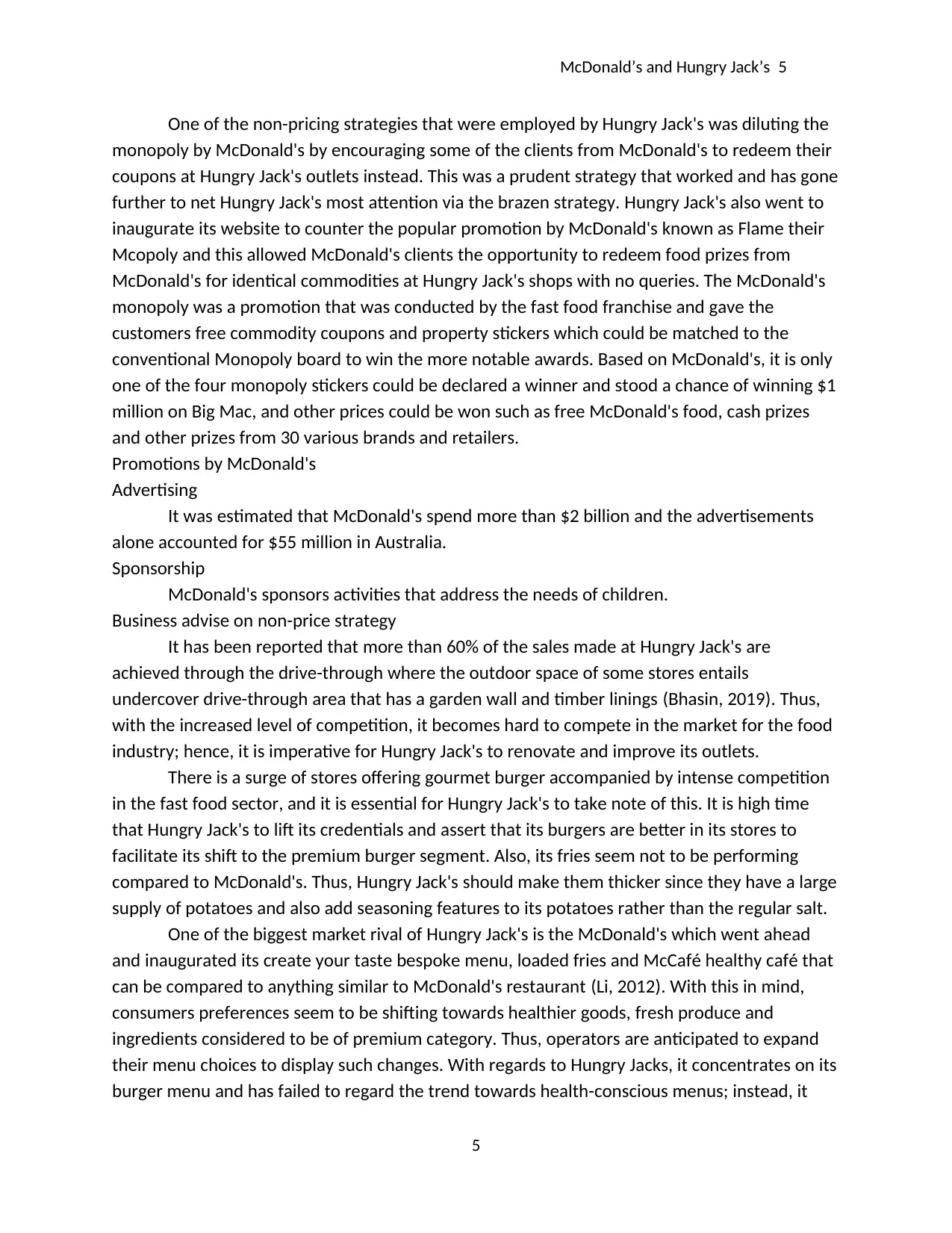
McDonald’s and Hungry Jack’s 5
One of the non-pricing strategies that were employed by Hungry Jack's was diluting the
monopoly by McDonald's by encouraging some of the clients from McDonald's to redeem their
coupons at Hungry Jack's outlets instead. This was a prudent strategy that worked and has gone
further to net Hungry Jack's most attention via the brazen strategy. Hungry Jack's also went to
inaugurate its website to counter the popular promotion by McDonald's known as Flame their
Mcopoly and this allowed McDonald's clients the opportunity to redeem food prizes from
McDonald's for identical commodities at Hungry Jack's shops with no queries. The McDonald's
monopoly was a promotion that was conducted by the fast food franchise and gave the
customers free commodity coupons and property stickers which could be matched to the
conventional Monopoly board to win the more notable awards. Based on McDonald's, it is only
one of the four monopoly stickers could be declared a winner and stood a chance of winning $1
million on Big Mac, and other prices could be won such as free McDonald's food, cash prizes
and other prizes from 30 various brands and retailers.
Promotions by McDonald's
Advertising
It was estimated that McDonald's spend more than $2 billion and the advertisements
alone accounted for $55 million in Australia.
Sponsorship
McDonald's sponsors activities that address the needs of children.
Business advise on non-price strategy
It has been reported that more than 60% of the sales made at Hungry Jack's are
achieved through the drive-through where the outdoor space of some stores entails
undercover drive-through area that has a garden wall and timber linings (Bhasin, 2019). Thus,
with the increased level of competition, it becomes hard to compete in the market for the food
industry; hence, it is imperative for Hungry Jack's to renovate and improve its outlets.
There is a surge of stores offering gourmet burger accompanied by intense competition
in the fast food sector, and it is essential for Hungry Jack's to take note of this. It is high time
that Hungry Jack's to lift its credentials and assert that its burgers are better in its stores to
facilitate its shift to the premium burger segment. Also, its fries seem not to be performing
compared to McDonald's. Thus, Hungry Jack's should make them thicker since they have a large
supply of potatoes and also add seasoning features to its potatoes rather than the regular salt.
One of the biggest market rival of Hungry Jack's is the McDonald's which went ahead
and inaugurated its create your taste bespoke menu, loaded fries and McCafé healthy café that
can be compared to anything similar to McDonald's restaurant (Li, 2012). With this in mind,
consumers preferences seem to be shifting towards healthier goods, fresh produce and
ingredients considered to be of premium category. Thus, operators are anticipated to expand
their menu choices to display such changes. With regards to Hungry Jacks, it concentrates on its
burger menu and has failed to regard the trend towards health-conscious menus; instead, it
5
One of the non-pricing strategies that were employed by Hungry Jack's was diluting the
monopoly by McDonald's by encouraging some of the clients from McDonald's to redeem their
coupons at Hungry Jack's outlets instead. This was a prudent strategy that worked and has gone
further to net Hungry Jack's most attention via the brazen strategy. Hungry Jack's also went to
inaugurate its website to counter the popular promotion by McDonald's known as Flame their
Mcopoly and this allowed McDonald's clients the opportunity to redeem food prizes from
McDonald's for identical commodities at Hungry Jack's shops with no queries. The McDonald's
monopoly was a promotion that was conducted by the fast food franchise and gave the
customers free commodity coupons and property stickers which could be matched to the
conventional Monopoly board to win the more notable awards. Based on McDonald's, it is only
one of the four monopoly stickers could be declared a winner and stood a chance of winning $1
million on Big Mac, and other prices could be won such as free McDonald's food, cash prizes
and other prizes from 30 various brands and retailers.
Promotions by McDonald's
Advertising
It was estimated that McDonald's spend more than $2 billion and the advertisements
alone accounted for $55 million in Australia.
Sponsorship
McDonald's sponsors activities that address the needs of children.
Business advise on non-price strategy
It has been reported that more than 60% of the sales made at Hungry Jack's are
achieved through the drive-through where the outdoor space of some stores entails
undercover drive-through area that has a garden wall and timber linings (Bhasin, 2019). Thus,
with the increased level of competition, it becomes hard to compete in the market for the food
industry; hence, it is imperative for Hungry Jack's to renovate and improve its outlets.
There is a surge of stores offering gourmet burger accompanied by intense competition
in the fast food sector, and it is essential for Hungry Jack's to take note of this. It is high time
that Hungry Jack's to lift its credentials and assert that its burgers are better in its stores to
facilitate its shift to the premium burger segment. Also, its fries seem not to be performing
compared to McDonald's. Thus, Hungry Jack's should make them thicker since they have a large
supply of potatoes and also add seasoning features to its potatoes rather than the regular salt.
One of the biggest market rival of Hungry Jack's is the McDonald's which went ahead
and inaugurated its create your taste bespoke menu, loaded fries and McCafé healthy café that
can be compared to anything similar to McDonald's restaurant (Li, 2012). With this in mind,
consumers preferences seem to be shifting towards healthier goods, fresh produce and
ingredients considered to be of premium category. Thus, operators are anticipated to expand
their menu choices to display such changes. With regards to Hungry Jacks, it concentrates on its
burger menu and has failed to regard the trend towards health-conscious menus; instead, it
5
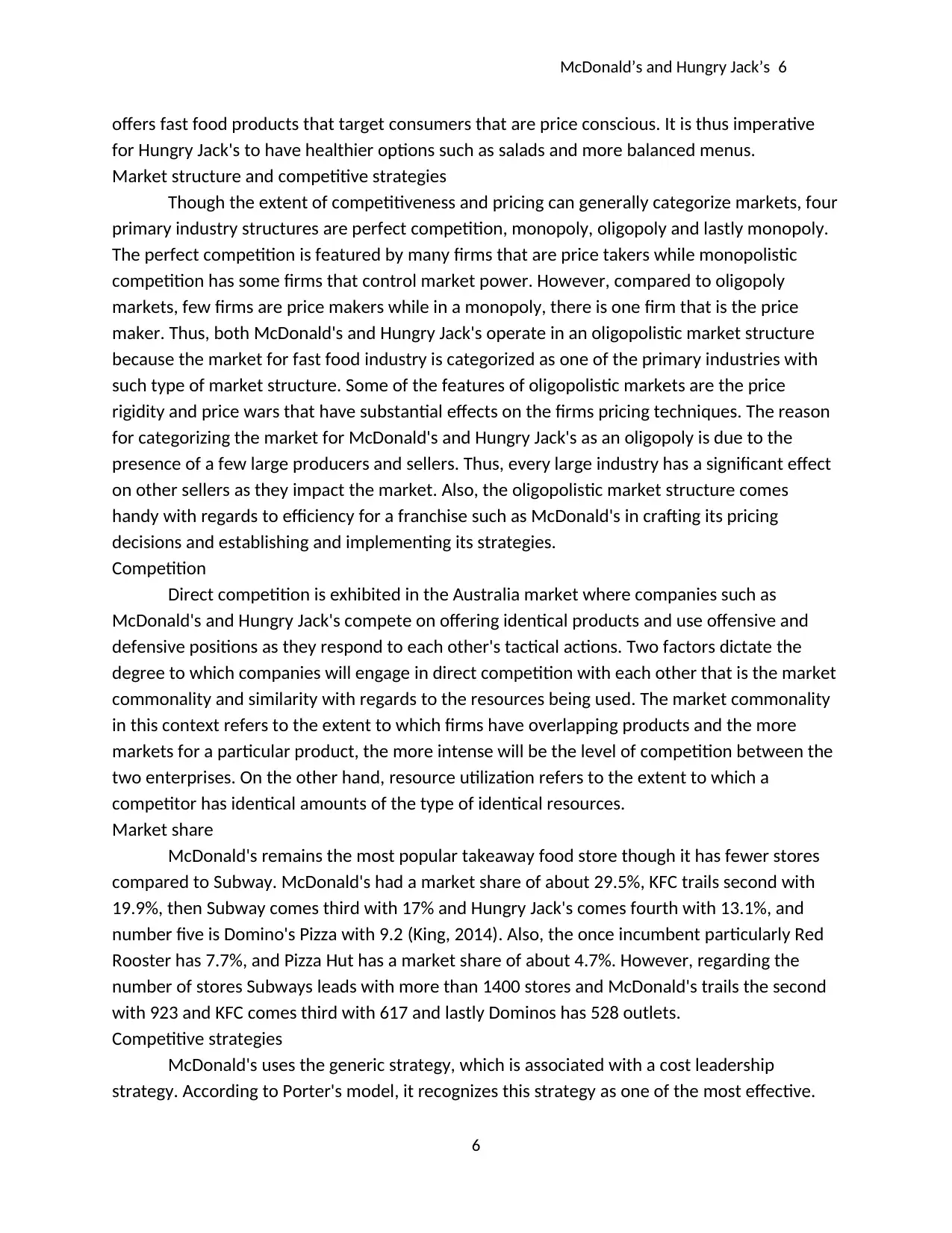
McDonald’s and Hungry Jack’s 6
offers fast food products that target consumers that are price conscious. It is thus imperative
for Hungry Jack's to have healthier options such as salads and more balanced menus.
Market structure and competitive strategies
Though the extent of competitiveness and pricing can generally categorize markets, four
primary industry structures are perfect competition, monopoly, oligopoly and lastly monopoly.
The perfect competition is featured by many firms that are price takers while monopolistic
competition has some firms that control market power. However, compared to oligopoly
markets, few firms are price makers while in a monopoly, there is one firm that is the price
maker. Thus, both McDonald's and Hungry Jack's operate in an oligopolistic market structure
because the market for fast food industry is categorized as one of the primary industries with
such type of market structure. Some of the features of oligopolistic markets are the price
rigidity and price wars that have substantial effects on the firms pricing techniques. The reason
for categorizing the market for McDonald's and Hungry Jack's as an oligopoly is due to the
presence of a few large producers and sellers. Thus, every large industry has a significant effect
on other sellers as they impact the market. Also, the oligopolistic market structure comes
handy with regards to efficiency for a franchise such as McDonald's in crafting its pricing
decisions and establishing and implementing its strategies.
Competition
Direct competition is exhibited in the Australia market where companies such as
McDonald's and Hungry Jack's compete on offering identical products and use offensive and
defensive positions as they respond to each other's tactical actions. Two factors dictate the
degree to which companies will engage in direct competition with each other that is the market
commonality and similarity with regards to the resources being used. The market commonality
in this context refers to the extent to which firms have overlapping products and the more
markets for a particular product, the more intense will be the level of competition between the
two enterprises. On the other hand, resource utilization refers to the extent to which a
competitor has identical amounts of the type of identical resources.
Market share
McDonald's remains the most popular takeaway food store though it has fewer stores
compared to Subway. McDonald's had a market share of about 29.5%, KFC trails second with
19.9%, then Subway comes third with 17% and Hungry Jack's comes fourth with 13.1%, and
number five is Domino's Pizza with 9.2 (King, 2014). Also, the once incumbent particularly Red
Rooster has 7.7%, and Pizza Hut has a market share of about 4.7%. However, regarding the
number of stores Subways leads with more than 1400 stores and McDonald's trails the second
with 923 and KFC comes third with 617 and lastly Dominos has 528 outlets.
Competitive strategies
McDonald's uses the generic strategy, which is associated with a cost leadership
strategy. According to Porter's model, it recognizes this strategy as one of the most effective.
6
offers fast food products that target consumers that are price conscious. It is thus imperative
for Hungry Jack's to have healthier options such as salads and more balanced menus.
Market structure and competitive strategies
Though the extent of competitiveness and pricing can generally categorize markets, four
primary industry structures are perfect competition, monopoly, oligopoly and lastly monopoly.
The perfect competition is featured by many firms that are price takers while monopolistic
competition has some firms that control market power. However, compared to oligopoly
markets, few firms are price makers while in a monopoly, there is one firm that is the price
maker. Thus, both McDonald's and Hungry Jack's operate in an oligopolistic market structure
because the market for fast food industry is categorized as one of the primary industries with
such type of market structure. Some of the features of oligopolistic markets are the price
rigidity and price wars that have substantial effects on the firms pricing techniques. The reason
for categorizing the market for McDonald's and Hungry Jack's as an oligopoly is due to the
presence of a few large producers and sellers. Thus, every large industry has a significant effect
on other sellers as they impact the market. Also, the oligopolistic market structure comes
handy with regards to efficiency for a franchise such as McDonald's in crafting its pricing
decisions and establishing and implementing its strategies.
Competition
Direct competition is exhibited in the Australia market where companies such as
McDonald's and Hungry Jack's compete on offering identical products and use offensive and
defensive positions as they respond to each other's tactical actions. Two factors dictate the
degree to which companies will engage in direct competition with each other that is the market
commonality and similarity with regards to the resources being used. The market commonality
in this context refers to the extent to which firms have overlapping products and the more
markets for a particular product, the more intense will be the level of competition between the
two enterprises. On the other hand, resource utilization refers to the extent to which a
competitor has identical amounts of the type of identical resources.
Market share
McDonald's remains the most popular takeaway food store though it has fewer stores
compared to Subway. McDonald's had a market share of about 29.5%, KFC trails second with
19.9%, then Subway comes third with 17% and Hungry Jack's comes fourth with 13.1%, and
number five is Domino's Pizza with 9.2 (King, 2014). Also, the once incumbent particularly Red
Rooster has 7.7%, and Pizza Hut has a market share of about 4.7%. However, regarding the
number of stores Subways leads with more than 1400 stores and McDonald's trails the second
with 923 and KFC comes third with 617 and lastly Dominos has 528 outlets.
Competitive strategies
McDonald's uses the generic strategy, which is associated with a cost leadership
strategy. According to Porter's model, it recognizes this strategy as one of the most effective.
6
⊘ This is a preview!⊘
Do you want full access?
Subscribe today to unlock all pages.

Trusted by 1+ million students worldwide
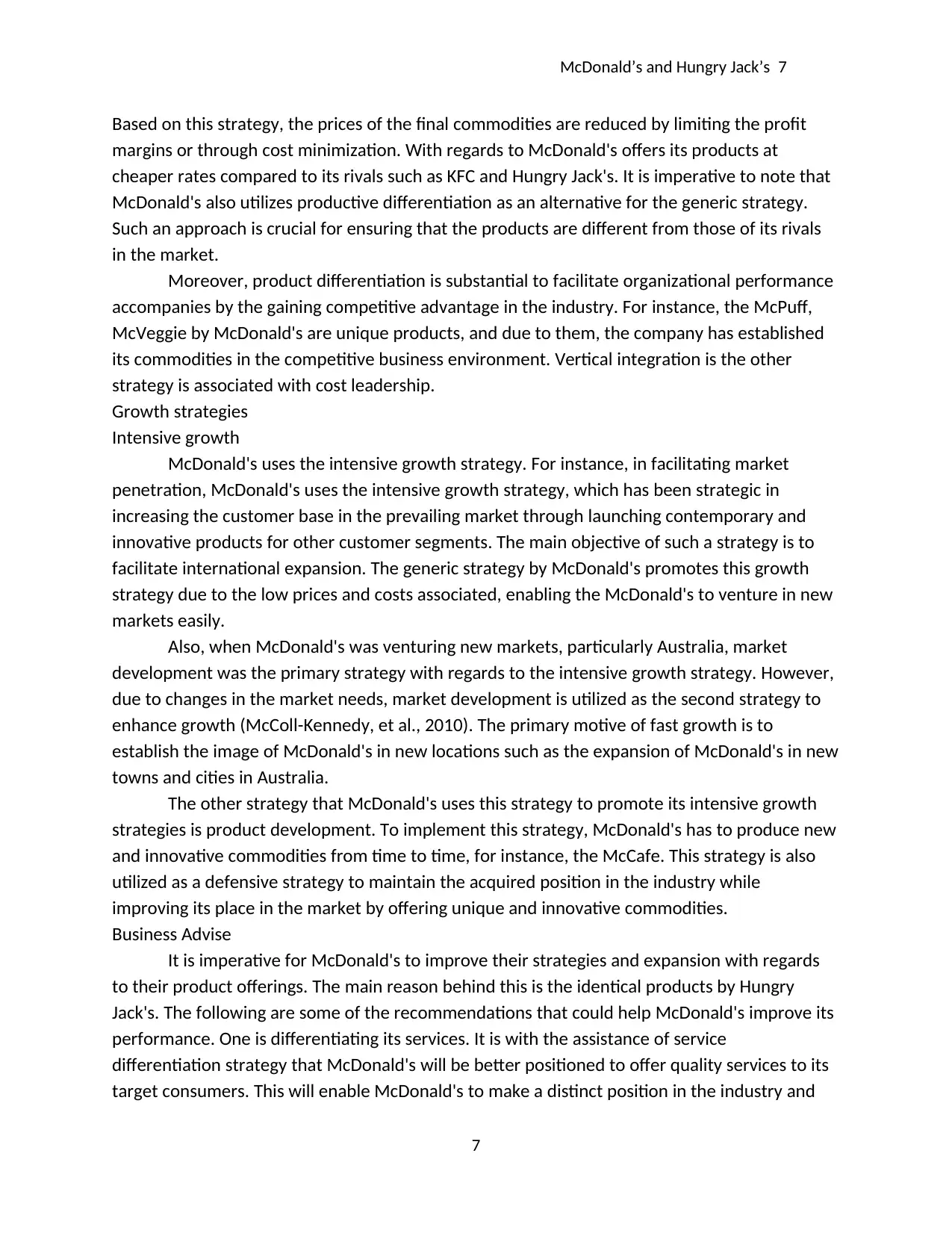
McDonald’s and Hungry Jack’s 7
Based on this strategy, the prices of the final commodities are reduced by limiting the profit
margins or through cost minimization. With regards to McDonald's offers its products at
cheaper rates compared to its rivals such as KFC and Hungry Jack's. It is imperative to note that
McDonald's also utilizes productive differentiation as an alternative for the generic strategy.
Such an approach is crucial for ensuring that the products are different from those of its rivals
in the market.
Moreover, product differentiation is substantial to facilitate organizational performance
accompanies by the gaining competitive advantage in the industry. For instance, the McPuff,
McVeggie by McDonald's are unique products, and due to them, the company has established
its commodities in the competitive business environment. Vertical integration is the other
strategy is associated with cost leadership.
Growth strategies
Intensive growth
McDonald's uses the intensive growth strategy. For instance, in facilitating market
penetration, McDonald's uses the intensive growth strategy, which has been strategic in
increasing the customer base in the prevailing market through launching contemporary and
innovative products for other customer segments. The main objective of such a strategy is to
facilitate international expansion. The generic strategy by McDonald's promotes this growth
strategy due to the low prices and costs associated, enabling the McDonald's to venture in new
markets easily.
Also, when McDonald's was venturing new markets, particularly Australia, market
development was the primary strategy with regards to the intensive growth strategy. However,
due to changes in the market needs, market development is utilized as the second strategy to
enhance growth (McColl-Kennedy, et al., 2010). The primary motive of fast growth is to
establish the image of McDonald's in new locations such as the expansion of McDonald's in new
towns and cities in Australia.
The other strategy that McDonald's uses this strategy to promote its intensive growth
strategies is product development. To implement this strategy, McDonald's has to produce new
and innovative commodities from time to time, for instance, the McCafe. This strategy is also
utilized as a defensive strategy to maintain the acquired position in the industry while
improving its place in the market by offering unique and innovative commodities.
Business Advise
It is imperative for McDonald's to improve their strategies and expansion with regards
to their product offerings. The main reason behind this is the identical products by Hungry
Jack's. The following are some of the recommendations that could help McDonald's improve its
performance. One is differentiating its services. It is with the assistance of service
differentiation strategy that McDonald's will be better positioned to offer quality services to its
target consumers. This will enable McDonald's to make a distinct position in the industry and
7
Based on this strategy, the prices of the final commodities are reduced by limiting the profit
margins or through cost minimization. With regards to McDonald's offers its products at
cheaper rates compared to its rivals such as KFC and Hungry Jack's. It is imperative to note that
McDonald's also utilizes productive differentiation as an alternative for the generic strategy.
Such an approach is crucial for ensuring that the products are different from those of its rivals
in the market.
Moreover, product differentiation is substantial to facilitate organizational performance
accompanies by the gaining competitive advantage in the industry. For instance, the McPuff,
McVeggie by McDonald's are unique products, and due to them, the company has established
its commodities in the competitive business environment. Vertical integration is the other
strategy is associated with cost leadership.
Growth strategies
Intensive growth
McDonald's uses the intensive growth strategy. For instance, in facilitating market
penetration, McDonald's uses the intensive growth strategy, which has been strategic in
increasing the customer base in the prevailing market through launching contemporary and
innovative products for other customer segments. The main objective of such a strategy is to
facilitate international expansion. The generic strategy by McDonald's promotes this growth
strategy due to the low prices and costs associated, enabling the McDonald's to venture in new
markets easily.
Also, when McDonald's was venturing new markets, particularly Australia, market
development was the primary strategy with regards to the intensive growth strategy. However,
due to changes in the market needs, market development is utilized as the second strategy to
enhance growth (McColl-Kennedy, et al., 2010). The primary motive of fast growth is to
establish the image of McDonald's in new locations such as the expansion of McDonald's in new
towns and cities in Australia.
The other strategy that McDonald's uses this strategy to promote its intensive growth
strategies is product development. To implement this strategy, McDonald's has to produce new
and innovative commodities from time to time, for instance, the McCafe. This strategy is also
utilized as a defensive strategy to maintain the acquired position in the industry while
improving its place in the market by offering unique and innovative commodities.
Business Advise
It is imperative for McDonald's to improve their strategies and expansion with regards
to their product offerings. The main reason behind this is the identical products by Hungry
Jack's. The following are some of the recommendations that could help McDonald's improve its
performance. One is differentiating its services. It is with the assistance of service
differentiation strategy that McDonald's will be better positioned to offer quality services to its
target consumers. This will enable McDonald's to make a distinct position in the industry and
7
Paraphrase This Document
Need a fresh take? Get an instant paraphrase of this document with our AI Paraphraser
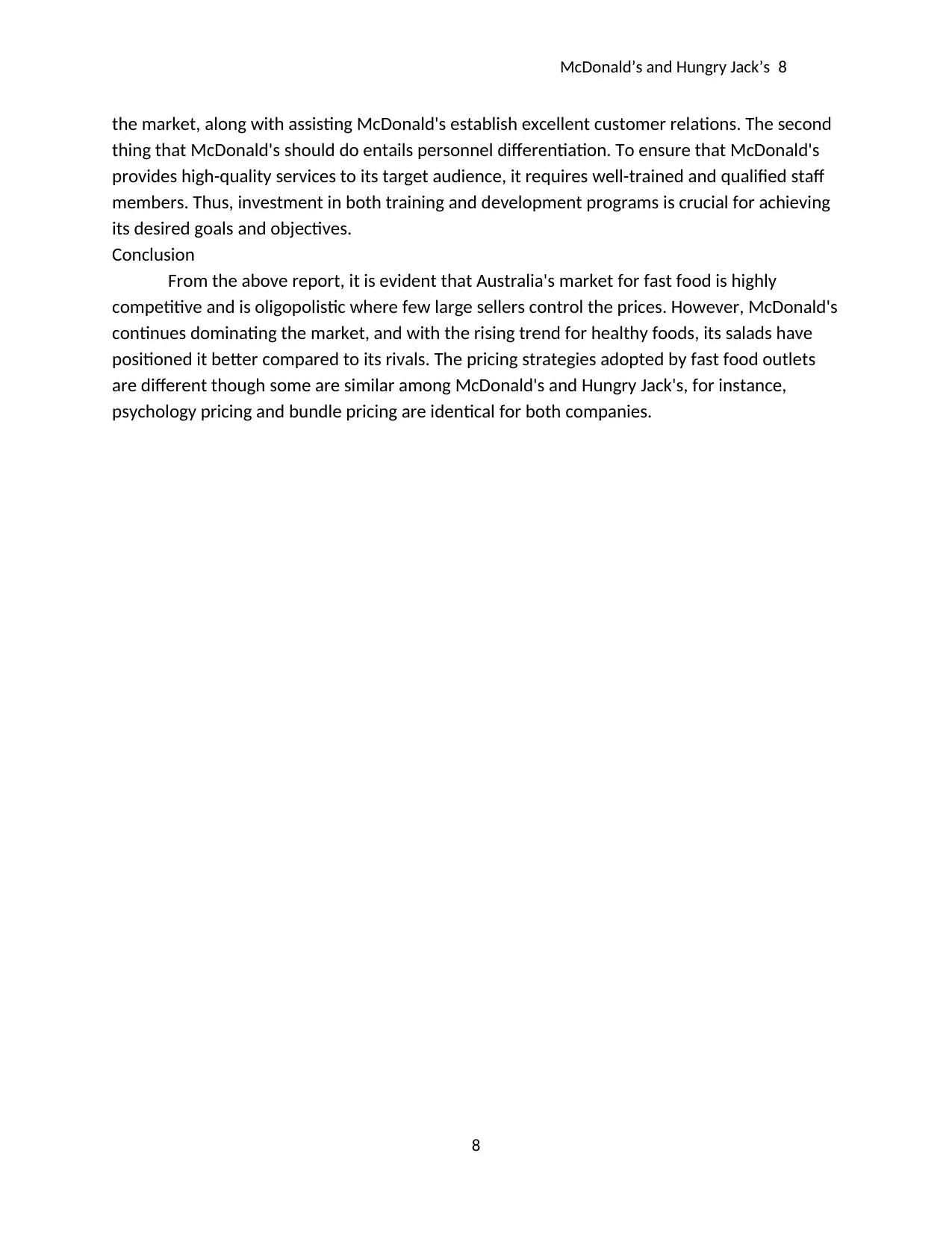
McDonald’s and Hungry Jack’s 8
the market, along with assisting McDonald's establish excellent customer relations. The second
thing that McDonald's should do entails personnel differentiation. To ensure that McDonald's
provides high-quality services to its target audience, it requires well-trained and qualified staff
members. Thus, investment in both training and development programs is crucial for achieving
its desired goals and objectives.
Conclusion
From the above report, it is evident that Australia's market for fast food is highly
competitive and is oligopolistic where few large sellers control the prices. However, McDonald's
continues dominating the market, and with the rising trend for healthy foods, its salads have
positioned it better compared to its rivals. The pricing strategies adopted by fast food outlets
are different though some are similar among McDonald's and Hungry Jack's, for instance,
psychology pricing and bundle pricing are identical for both companies.
8
the market, along with assisting McDonald's establish excellent customer relations. The second
thing that McDonald's should do entails personnel differentiation. To ensure that McDonald's
provides high-quality services to its target audience, it requires well-trained and qualified staff
members. Thus, investment in both training and development programs is crucial for achieving
its desired goals and objectives.
Conclusion
From the above report, it is evident that Australia's market for fast food is highly
competitive and is oligopolistic where few large sellers control the prices. However, McDonald's
continues dominating the market, and with the rising trend for healthy foods, its salads have
positioned it better compared to its rivals. The pricing strategies adopted by fast food outlets
are different though some are similar among McDonald's and Hungry Jack's, for instance,
psychology pricing and bundle pricing are identical for both companies.
8
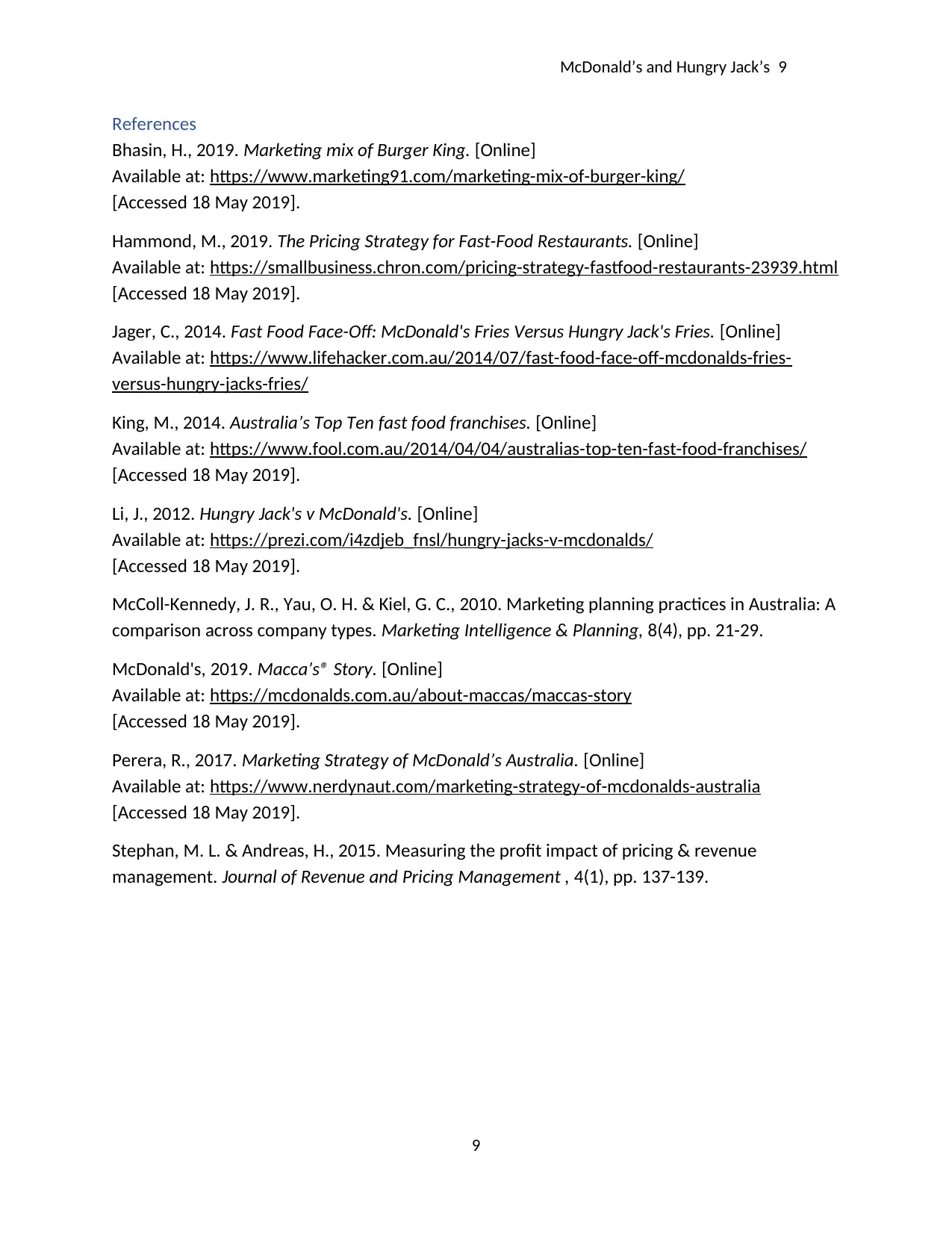
McDonald’s and Hungry Jack’s 9
References
Bhasin, H., 2019. Marketing mix of Burger King. [Online]
Available at: https://www.marketing91.com/marketing-mix-of-burger-king/
[Accessed 18 May 2019].
Hammond, M., 2019. The Pricing Strategy for Fast-Food Restaurants. [Online]
Available at: https://smallbusiness.chron.com/pricing-strategy-fastfood-restaurants-23939.html
[Accessed 18 May 2019].
Jager, C., 2014. Fast Food Face-Off: McDonald's Fries Versus Hungry Jack's Fries. [Online]
Available at: https://www.lifehacker.com.au/2014/07/fast-food-face-off-mcdonalds-fries-
versus-hungry-jacks-fries/
King, M., 2014. Australia’s Top Ten fast food franchises. [Online]
Available at: https://www.fool.com.au/2014/04/04/australias-top-ten-fast-food-franchises/
[Accessed 18 May 2019].
Li, J., 2012. Hungry Jack's v McDonald's. [Online]
Available at: https://prezi.com/i4zdjeb_fnsl/hungry-jacks-v-mcdonalds/
[Accessed 18 May 2019].
McColl-Kennedy, J. R., Yau, O. H. & Kiel, G. C., 2010. Marketing planning practices in Australia: A
comparison across company types. Marketing Intelligence & Planning, 8(4), pp. 21-29.
McDonald's, 2019. Macca’s® Story. [Online]
Available at: https://mcdonalds.com.au/about-maccas/maccas-story
[Accessed 18 May 2019].
Perera, R., 2017. Marketing Strategy of McDonald’s Australia. [Online]
Available at: https://www.nerdynaut.com/marketing-strategy-of-mcdonalds-australia
[Accessed 18 May 2019].
Stephan, M. L. & Andreas, H., 2015. Measuring the profit impact of pricing & revenue
management. Journal of Revenue and Pricing Management , 4(1), pp. 137-139.
9
References
Bhasin, H., 2019. Marketing mix of Burger King. [Online]
Available at: https://www.marketing91.com/marketing-mix-of-burger-king/
[Accessed 18 May 2019].
Hammond, M., 2019. The Pricing Strategy for Fast-Food Restaurants. [Online]
Available at: https://smallbusiness.chron.com/pricing-strategy-fastfood-restaurants-23939.html
[Accessed 18 May 2019].
Jager, C., 2014. Fast Food Face-Off: McDonald's Fries Versus Hungry Jack's Fries. [Online]
Available at: https://www.lifehacker.com.au/2014/07/fast-food-face-off-mcdonalds-fries-
versus-hungry-jacks-fries/
King, M., 2014. Australia’s Top Ten fast food franchises. [Online]
Available at: https://www.fool.com.au/2014/04/04/australias-top-ten-fast-food-franchises/
[Accessed 18 May 2019].
Li, J., 2012. Hungry Jack's v McDonald's. [Online]
Available at: https://prezi.com/i4zdjeb_fnsl/hungry-jacks-v-mcdonalds/
[Accessed 18 May 2019].
McColl-Kennedy, J. R., Yau, O. H. & Kiel, G. C., 2010. Marketing planning practices in Australia: A
comparison across company types. Marketing Intelligence & Planning, 8(4), pp. 21-29.
McDonald's, 2019. Macca’s® Story. [Online]
Available at: https://mcdonalds.com.au/about-maccas/maccas-story
[Accessed 18 May 2019].
Perera, R., 2017. Marketing Strategy of McDonald’s Australia. [Online]
Available at: https://www.nerdynaut.com/marketing-strategy-of-mcdonalds-australia
[Accessed 18 May 2019].
Stephan, M. L. & Andreas, H., 2015. Measuring the profit impact of pricing & revenue
management. Journal of Revenue and Pricing Management , 4(1), pp. 137-139.
9
⊘ This is a preview!⊘
Do you want full access?
Subscribe today to unlock all pages.

Trusted by 1+ million students worldwide
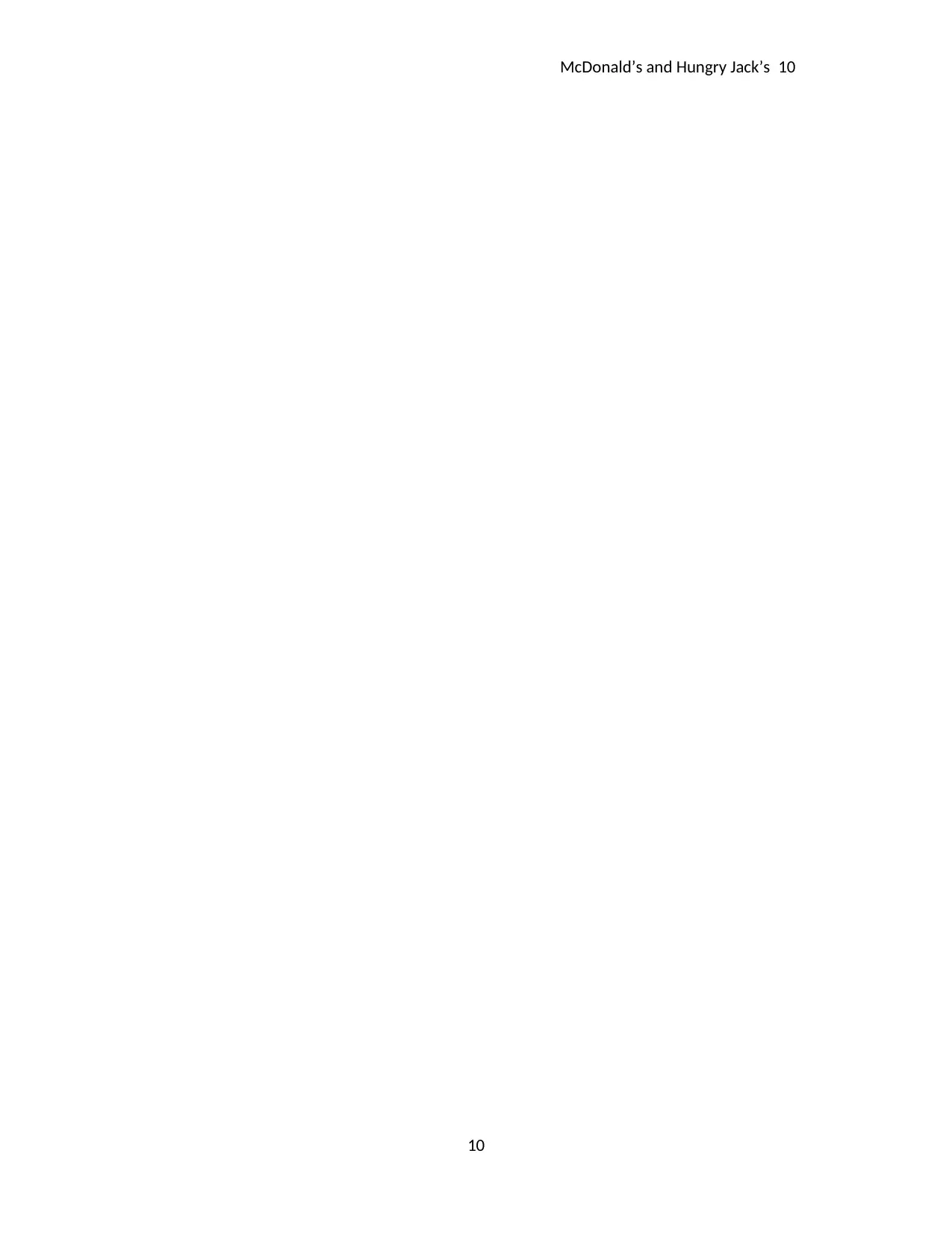
McDonald’s and Hungry Jack’s 10
10
10
1 out of 10
Related Documents
Your All-in-One AI-Powered Toolkit for Academic Success.
+13062052269
info@desklib.com
Available 24*7 on WhatsApp / Email
![[object Object]](/_next/static/media/star-bottom.7253800d.svg)
Unlock your academic potential
Copyright © 2020–2025 A2Z Services. All Rights Reserved. Developed and managed by ZUCOL.





